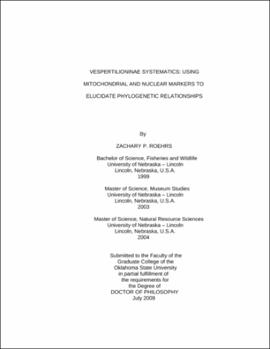| dc.contributor.advisor | Van Den Bussche, Ronald A. | |
| dc.contributor.author | Roehrs, Zachary P. | |
| dc.date.accessioned | 2013-11-26T08:28:24Z | |
| dc.date.available | 2013-11-26T08:28:24Z | |
| dc.date.issued | 2009-07 | |
| dc.identifier.uri | https://hdl.handle.net/11244/7043 | |
| dc.description.abstract | Scope and Method of Study: Elucidating evolutionary relationships within Vespertilioninae has been challenging due to a paucity of useful morphological characters, convergent evolution of lineages, and potentially rapid radiation of the major clades in this subfamily of bats. Previous molecular studies of this subfamily using mitochondrial ribosomal DNA were unable to explicate deep phylogenetic relationships. I used 3 nuclear exons (APOB, DMP1, RAG2), 3 nuclear introns (PRKCI, STAT5A, THY), and existing mtDNA (12S rRNA, tRNAVal, and 16S rRNA) gene regions in maximum parsimony and Bayesian phylogenetic analyses to generate hypotheses of the evolutionary relationship of Vespertilioninae and test previous hypotheses about interand intratribal relationships. | |
| dc.description.abstract | Findings and Conclusions: Analyses of >8 Kilo-bases of digenomic DNA were not able to fully resolve all deep phylogenetic relationships. However, gene trees using this dataset were more resolved than mtDNA alone and provided a more robust hypothesis of the evolution of Vespertilioninae. These results support the existence of 7 tribes within Vespertilioninae (Antrozoini, Lasiurini, Hypsugine group, Nycticeiini / Eptesicini, Perimyotine group, Scotophilini, and Vespertilionini). Three of these tribes (Hypsugine group, Perimyotine group, and Vespertilionini) constitute new hypotheses for the relationship of these bats and 2 are in need of formal description. The only intertribal relationship supported was a sister relationship between the Hypsugine group and Vespertilionini. The tribe Plecotini was neither supported nor rejected in these gene trees. Due to the remaining unresolved relationships generated by this relatively large dataset, which incorporated gene regions successfully used to resolve other similar mammalian phylogenetic questions, it is apparent that more DNA sequence data and implementation of new techniques to reduce systematic errors in large molecular datasets will be required to resolve these deep evolutionary relationships in Vespertilioninae. | |
| dc.format | application/pdf | |
| dc.language | en_US | |
| dc.rights | Copyright is held by the author who has granted the Oklahoma State University Library the non-exclusive right to share this material in its institutional repository. Contact Digital Library Services at lib-dls@okstate.edu or 405-744-9161 for the permission policy on the use, reproduction or distribution of this material. | |
| dc.title | Vespertilioninae systematics: Using mitochondrial and nuclear markers to elucidate phylogenetic relationships | |
| dc.contributor.committeeMember | Hamilton, Meredith J. | |
| dc.contributor.committeeMember | Leslie, David M., Jr. | |
| dc.contributor.committeeMember | Tyrl, Ronald J. | |
| dc.contributor.committeeMember | Braun, Janet K. | |
| osu.filename | Roehrs_okstate_0664D_10407.pdf | |
| osu.accesstype | Open Access | |
| dc.type.genre | Dissertation | |
| dc.type.material | Text | |
| dc.subject.keywords | chiroptera | |
| dc.subject.keywords | mtdna | |
| dc.subject.keywords | nuclear dna | |
| dc.subject.keywords | phylogenetics | |
| dc.subject.keywords | systematics | |
| dc.subject.keywords | vespertilioninae | |
| thesis.degree.discipline | Zoology | |
| thesis.degree.grantor | Oklahoma State University | |
